| |||||||||||||||||||||||||||||||
| |||||||||||||||||||||||||||||||
| |||||||||||||||||||||||||||||||
The Argentine general election of 1946, the last for which only men were enfranchised, was held on 24 February. Voters chose both the President and their legislators and with a turnout of 83.4%, it produced the following results:
| |||||||||||||||||||||||||||||||
| |||||||||||||||||||||||||||||||
| |||||||||||||||||||||||||||||||
The Argentine general election of 1946, the last for which only men were enfranchised, was held on 24 February. Voters chose both the President and their legislators and with a turnout of 83.4%, it produced the following results:
| Party/Electoral Alliance | Votes | Percentage | Electoral College |
|---|---|---|---|
| Labour Party | 1,487,866 | 52.8% | 299 |
| Democratic Union (Alliance of the Radical Civic Union (UCR), Socialist Party, conservatives and Communist Party) | 1,207,080 | 42.9% | 66 |
| National Democratic Party | 43,499 | 1.5% | |
| Others | 77,307 | 2.7% | |
| Positive votes | 2,855,192 | 99.2% | 365 |
| Blank and nullified votes | 23,735 | 0.8% | 11 a |
| Total votes | 2,878,927 | 100.0% | 376 |
aAbstentions.
| Party/Electoral Alliance | Seats | % of votes |
|---|---|---|
| Labour Party | 101 | 43.7% |
| Radical Civic Union (UCR) | 44 | 27.6% |
| Democratic Union (allied to the UCR) | 5 | 13.9% |
| Others | 8 | 14.8% |
| Total | 158 | 100.0% |
Conservative rule, maintained through electoral fraud despite a moderate record, was brought to an end in a June 1943 coup d'état. Barking "orders of the day" every morning on the radio, the new regime enjoyed little approval. The devastating 1944 San Juan earthquake presented an opportunity to regain lost goodwill and the regime moved quickly, involving the private sector through nationwide fund-raising, entrusted to the Labor Minister, Juan Perón. Perón enlisted celebrities for the effort, among which was a radio matinee star of middling talent, Eva Duarte, who introduced herself to the Labor Minister by remarking that "nothing's missing, except a touch of Atkinson's". The effort's success and the rise of his ally, Edelmiro Farrell, within the junta, led to Perón's appointment as vice-president, which he leveraged in support of Argentina's struggling labor unions, particularly the CGT.

The 1944 San Juan earthquake took place in the province of San Juan, in the center-west area of Argentina, a region highly prone to seismic events. This moderate to strong earthquake destroyed a large part of San Juan, the provincial capital, and killed 10,000 of its inhabitants, 10% of its population at the time. One third of the province population became homeless. It is acknowledged as the worst natural disaster in Argentine history.

Juan Domingo Perón was an Argentine Army general and politician. After serving in several government positions, including Minister of Labor and Vice President, he was elected President of Argentina three times, serving from June 1946 to September 1955, when he was overthrown in a coup d'état, and then from October 1973 until his death in July 1974.

The General Confederation of Labor of the Argentine Republic is a national trade union federation in Argentina founded on September 27, 1930, as the result of the merger of the USA and the COA trade unions. Nearly one out of five employed - and two out of three unionized workers in Argentina - belong to the CGT, one of the largest labor federations in the world.

Perón's sudden clout led to growing rivalry among his junta colleagues, who had him arrested on October 9, a surprise move outdone by CGT leaders like retail workers' leader Ángel Borlenghi, the slaughterhouses' Cipriano Reyes and Eva Duarte, herself. Organizing a mass (and, at times, violent) demonstration for his release on the Plaza de Mayo, their October 17, 1945, mobilization marked a turning point in Argentine history: the creation of the Peronist movement. Capitulating to the political winds, the junta bestowed presidential powers on Perón, who initiated his program of mass nationalizations of institutions such as the universities and Central Bank. Calling elections for February 1946, Perón's opposition hastily arranged an alliance, the Democratic Union. Many in the centrist Radical Civic Union were steadfastly opposed to this ad hoc union with conservatives and the left, an intrinsic burden compounded by a white paper scathingly critical of Perón released by the U.S. Ambassador, Spruille Braden. The report, accusing Perón of fascist ties, allowed him to marginalize the Democratic Union (and their distinguished, though disastrously-named nominees, José Tamborini and Enrique Mosca – the "tambourine and the fly"). He quickly reframed the argument as one between "Perón or Braden", making this his rallying cry and winning the 1946 elections handily.

Ángel Borlenghi was an Argentine labour leader and politician closely associated with the Peronist movement.

The Plaza de Mayo is a city square and main foundational site of Buenos Aires, Argentina. It was formed in 1884 after the demolition of the Recova building, unifying the city's Plaza Mayor and Plaza de Armas, by that time known as Plaza de la Victoria and Plaza 25 de Mayo respectively. The city centre of Buenos Aires, Plaza de Mayo has been the scene of the most momentous events in Argentine history, as well as the largest popular demonstrations in the country. On the occasion of the one-year anniversary of the May Revolution in 1811, the Pirámide de Mayo was inaugurated in the square's hub, becoming Buenos Aires' first national monument.
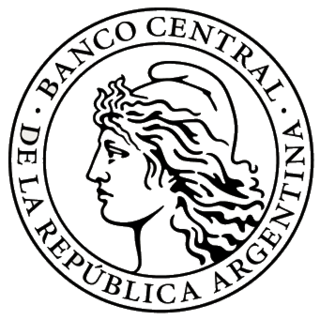
The Central Bank of the Argentine Republic is the central bank of Argentina.

Peronism or Justicialism (justicialismo) is an Argentine political movement based on the political ideology and legacy of former President Juan Domingo Perón and his second wife Eva Perón.

Buenos Aires is the largest and most populous Argentinian province. It takes the name from the city of Buenos Aires, which used to be part of the province and the provincial capital until it was federalized in 1880. Since then, in spite of bearing the same name, the province does not include the national capital city proper, though it does include all other localities of the Greater Buenos Aires metropolitan area surrounding it. The current capital of the province is the city of La Plata, founded in 1882.

José Tamborini was an Argentine physician and historically significant politician.

Arturo Frondizi Ercoli was an Argentine politician and lawyer who was President of Argentina from 1 May 1958 until 29 March 1962, for the Intransigent Radical Civic Union, which he led until 1986.

José Alonso was an Argentine politician and trade-unionist.
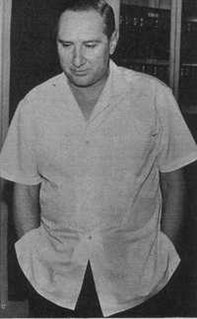
Augusto Timoteo Vandor was an Argentine trade unionist leader, naval non-commissioned officer and politician.
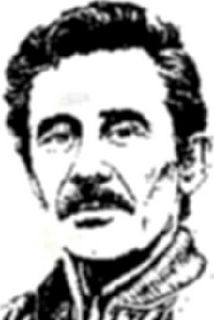
José Ignacio Rucci was an Argentine politician and union leader, appointed general secretary of the CGT in 1970. Close to the Argentine president Juan Perón, and a chief representative of the "syndical bureaucracy" ; he was assassinated in 1973.

Argentine Revolution was the name given by its leaders to a military coup d'état which overthrew the government of Argentina in June 1966 and began a period of military dictatorship by a junta from then until 1973.
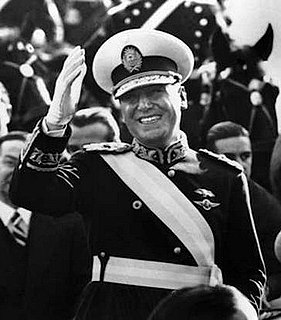
The Argentine general election of 1951, the first to have enfranchised women at the national level, was held on 11 November. Voters chose both the President of Argentina and their legislators and with a turnout of 88.0%, it produced the following results:
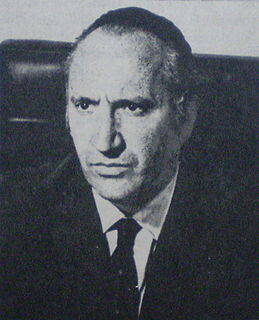
Lorenzo Miguel was a prominent Argentine labor leader closely associated with the steelworkers' union.
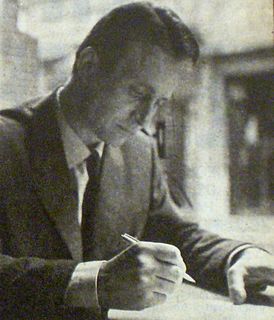
Raimundo José Ongaro was an Argentine union leader. He was secretary general of the General Confederation of Labour of the Argentines (CGTA) between 1968 and 1974.

Nicolás Repetto was an Argentine physician and leader of the Socialist Party of Argentina.

Andrés Framini was an Argentine labor leader and politician.
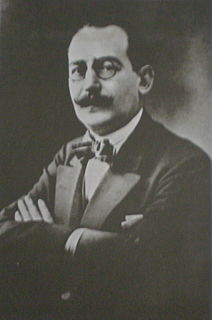
Enrique Mosca was an Argentine lawyer and politician prominent in the centrist Radical Civic Union (UCR).

Domingo Mercante was an Argentine military officer and governor of the province of Buenos Aires. He stood out as one of the initiators of Peronism, organizing labor mobilizations that ended on 17 October 1945 with the release of Juan Domingo Perón.
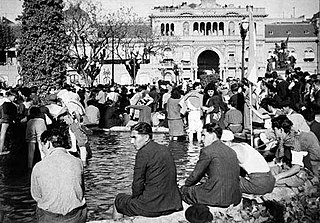
Loyalty Day is a commemoration day in Argentina. It remembers October 17, 1945, when a massive labour demonstration at Plaza de Mayo demanded the liberation of Juan Domingo Perón, who was jailed in Martín García island. It is considered the foundation day of Peronism.
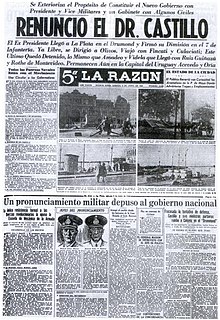
The 1943 Argentine coup d'état, also known as the Revolution of '43, was a coup d'état on June 4, 1943, which ended the government of Ramón Castillo, who had been fraudulently elected to the office of vice-president, as part of the period known as the Infamous Decade. The military was opposed to Governor Robustiano Patrón Costas, Castillo's hand-picked successor, a major landowner in the Salta Province and a primary stockholder in the sugar industry. The only serious resistance to the military coup came from the Argentine Navy, which confronted the advancing army columns at the Navy Petty-Officers School of Mechanics.

Juan Atilio Bramuglia was an Argentine labor lawyer who served as Minister of Foreign Affairs during the administration of President Juan Perón.

Popular Union is a political party in Argentina rooted in Peronism and a current of Justicialist Party. Established by Juan Atilio Bramuglia as both a contingency for Peronists displaced by the 1955 military coup against the populist President Juan Perón, it became a "neo-Peronist" alternative to the exiled leader's line, and subsequently, an alternative to the successive dominant factions in the Justicialist Party. The UP re-emerged as a political force during the 2011 elections, when it was adopted as a vehicle by Eduardo Duhalde ahead of the Federal Peronist primaries on August 14.